
America’s shale boom could be about to spare the world’s oil tanker owners from a typical OPEC ravaging.
The producer group and allies decided on Dec. 7 to restrict output from the start of next year by about 1.2 million barrels a day, adding to deeper cuts two years earlier. Under normal circumstances, that would be a dire turn of events for owners who see cargoes cut almost overnight. But shipping analysts are predicting that, this time, the rise of U.S. shale may well shield shippers.
“OPEC+ is reducing their output as U.S. is increasing theirs, hence the overall limited effect for tanker volumes,” said Frode Morkedal, managing director of equity research at Clarksons Platou, an investment banking unit of the world’s biggest shipbroker.
If owners do weather the storm, it would underscore the central dilemma facing the Organization of Petroleum Exporting Countries as it tries to prop up prices: deeper output cuts risk spurring rival production, especially shale. The idea of the tanker industry withstanding heavy reductions in OPEC production would have been almost unthinkable a few years ago, given the group’s vital importance to seaborne trade.
Cuts Covered
Saudi Arabia, the world’s biggest exporter, pledged on Dec. 7 that it would pump almost 1 million barrels a day less in January than in November. At the same time, the U.S. just became a net oil exporter for the first time in 75 years.
U.S. production will expand at a rate of 1.18 million barrels a day in 2019, the Energy Information Administration said Wednesday in its monthly outlook. That’s almost exactly the amount that OPEC+ pledged to curb — for the first six months of the year.
Production Surge
As U.S. production surges, ports are racing to build facilities to serve supertankers that normally haul cargoes to Asia. The Louisiana Offshore Oil Port, the nation’s biggest deepwater facility, began supertanker exports back in February. On Dec. 9, it said it had completed the loading of three very large crude carriers with U.S. domestic crude in the prior seven days.
Increased U.S. exports to Asia mean tankers will need to travel longer distances than when sailing from their usual export ports in the Persian Gulf too, potentially further reducing availability. As well as LOOP, supertankers can load cargoes in the Gulf of Mexico from smaller ships that themselves collected the barrels from export terminals.
“U.S. crude exports are expect to continue to grow rapidly, adding considerable relief from the OPEC cut and increase in vessel supply,” Fotis Giannakoulis, an analyst at Morgan Stanley, said in a note.
It’s not just shale that’s helping owners. Slowing fleet growth and new fuel rules are further boons.
The global fleet hardly grew in the third and fourth quarters, even if capacity will expand at a faster rate next year, according to Clarkson Research. Additionally, the industry is starting to prepare for sulfur-reduction rules set out by the International Maritime Organization, which begin in January 2020. That’s expected to further reduce supply of available ships from early next year as the carriers start going to shipyards to get ready, according to Morgan Stanley.
Not everything is good news for owners. Oil prices have been slumping in part because of questions about demand and amid fears that a U.S.-China trade spat could hinder growth. If that happens, then the tanker market wouldn’t be immune. Giannakoulis says he does still expect OPEC’s curbs to hurt freight rates.
Still, things could be worse. Moerkedal, the Clarkson analyst, expects VLCCs to earn $31,000 a day next year, down from $34,000 that he was anticipating before the OPEC decision. The lower rates would still be good in historical terms.
“The development may prove positive for the VLCC market by pushing Asian crude buyers further afield to the Atlantic basin,” George Los, senior tanker markets analyst at Charles R. Weber Co. in Greenwich, Connecticut, said of the OPEC+ curbs.